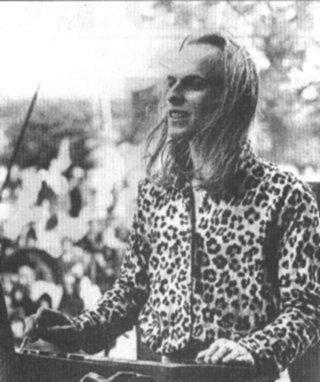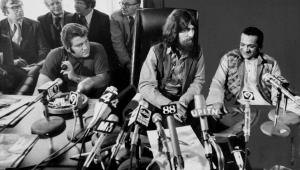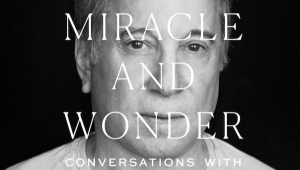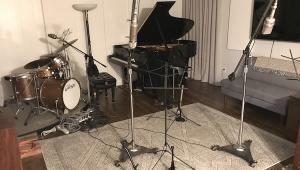Brian Eno: Perfect Masters Thrive On Disasters Part 2

A year after Taking Tiger Mountain (By Strategy) and world's apart from it, Eno released what many consider to be his most innovative and evocative album, Another Green World. It took two months to produce-twice as long as each of the previous two albums. Though synthesizer based, the album sounds organic and almost leafy. The set of mostly short, prehistoric and tropical sounding instrumental collages marked a distinct turning point for Eno, a change that would eventually come to dominate his solo recorded efforts and profoundly affect his collaborations with other.
Before recording began, Eno and artist Peter Schmidt created a deck of cards that they called "Oblique Strategies". The cards, each of which contained a specific instruction, were like a more sophisticated version of the old "Magic Eight Ball,” which only answered "yes" or "no". The cards were more about exploring possibilities and choosing directions. Eno used them to help guide him in the production of the record.
For the first time, many of the tracks are all Eno—on "desert" guitars (whatever they are), synthesizers, Farfisa organ, and effects devices. On a few cuts, Eno is joined by Phil Collins, John Cale, Robert Fripp and other British "progressive" musicians. With the exception of two ballads, "I'll Come Running To Tie Your Shoes" , and "Everything Merges With the Night" which are fully realized songs with vocals, the other tracks sound improvised, and more like segments which begin, build and then just trail off when whatever juice the experiment yielded, dried up. Some are short fragments, other last longer.
Another Green World marked a sea change for Eno, musically and image-wise. Gone was the long hair, the make-up and the weirdness. Instead, the green tinged monochrome back cover photo shows a contemplative, bare chested, rather delicate looking youth reading a book. Also gone were all musical references to rock's strict time. Nothing on the record rocks. Some of the sonic miniatures are without rhythmic signatures; those with a beat are convoluted and heavily syncopated.
Having led a small but dedicated pop music audience to the edges of the avant-garde with his first two albums, here Eno pushed them overboard. Back in his art school days he'd performed a 90 minute La Monte Young piece and he'd built two versions of "Drip Event"—an avant-garde experimental work of art. On Another Green World Eno presents rock listeners with few familiar guideposts, but the warm inviting sonic other- world he creates, helps settle them into the work.
The album begins with "Skysaw", an oddly metered piece featuring a percolating bass line over Phil Collins' drum kit accompanied by angular crosscut "snake guitar" distortions played by Eno, a Fender Rhodes piano in the backdrop and a "heave ho" sounding viola section courtesy John Cale. Eno sets up his listeners for what's to come with a short lyrical outburst: "All the parts turn to words, All the words grow to secrets, No one knows what they mean, Everyone just ignores them." Lyrics worth considering when listening to all four of these recordings!
That said, the instrumental vignettes begin with "Over Fire Island", a mysterious fretless bass driven miniature, featuring odd sonic drive-bys: doppler effected synth fly-overs, and buzzing electronic hot plates punctuated by percussive drum drops. The piece neither ends nor begins, it just sort of pokes its head through the undergrowth, turns and disappears.
Next up is the album's stunner, "St. Elmo's Fire" which features one of Robert Fripp's most perfectly realized guitar solos, a cool, twisting, yearning figure that jumps and bubbles under and over Eno's evocative lyrics set beneath a "cool August moon". It's a track that sounds best played on a hot summer evening, not surprisingly.
Of the four Eno albums covered here, Another Green World is the most visual and evocative. The sonic pictures painted are at once mysterious and familiar. It is as if Eno is putting sounds to the most basic and primitive thoughts and feelings we encounter in dreams and in the state between sleep and consciousness.
Using just a rhythm machine and simple synth chords, on "The Big Ship", Eno conjures up a cathedral's worth of basic human longings and feelings, building the piece to a sonic climax and then letting it slowly drift off and disappear. The listener is left frozen in the moment-at peace, yet unsettled.
After the lyrically enigmatic but musically conventional ballad "I'll Come Running to Tie Your Shoes", in which Fripp again provides a brilliant guitar counterpoint to Eno's simple, though lovely melody, the side ends with the title track, another short sonic experiment based on the simplest musical construct.
"Sombre Reptiles" sounds just like it reads, giving the listener the feeling that perhaps Eno too, came away from the album feeling as if he'd created a modern day sonic “Fantasia,” at least that's my take on Another Green World an album with far reaching consequences for post seventies instrumental music, not the least of which was the creation of "Newage" as in "sewage" music.
It would be wholly unfair to blame Eno for that revoltin' development as nothing here remotely approaches the treacly, "beautiful" so pleasant it's unpleasant cornpone that is most of what's called "New Age". End editorial.
The sound on Another Green World, again by Rhett Davies (who co-produced the album with Eno), is a step above Taking Tiger Mountain (By Strategy) yet again more dynamic, more sensational, with deeper bass, more liquid mid-bass, richer midrange and snappier and more extended highs without a trace of edge or brittleness. Occasionally some tape hiss intrudes into the picture.
Spatially, Another Green World presents a three dimensional picture with superb front to back and side to side layering of sonic elements and a refreshing cushion of air. The organic feel Eno obviously went for is achieved in part by judicious use of reverb, which is never really expressed as an audible element as it was on previous Eno productions. Rather it is used to fill out space and add depth.
Depending on your system, you might prefer either the rare original British Island (ILPS 9351), the second pressing, (British Polydor Deluxe 2302 069) or the Japanese Polydor (MPF 1153) which I replaced my British second press with when it became available to me in the mid-eighties. (Luckily, I found a British pressing recently for six bucks at a used record store in Denver CO.) The Another Green World originally issued in America on Island (ILPS 9351) then distributed by Warner Brothers, is sonically indistinguished.
The British pressing has the most neutral tonal balance of the three vinyl versions I had on hand, with the sharpest and fastest high frequency transients. It's a bit thin in the middle compared to the Japanese pressing, which gives the British stiff competition, though it's a bit bloated in the mid bass. Either one will do.
The blue label American Island original, mastered by Sterling is slow and sluggish on bottom and recessed on top. It sounds as if it was mastered using a poorly made transfer froma second generation tape. It is however, inexpensive and easy to find at used record stores, as are later Editions E.G. pressings, one of which I did not have on hand for this story.
Be sure to check under both "Eno" and "New Age instrumentals" sections when you go looking for Eno. I've seen copies of all four of these albums filed both ways. If you're embarrassed to be seen bellying up to the "New Age" bar, wear an oversized hat. Eno albums do not belong in the "New Age" section for you used record store owners out there.
The Caroline/EG CD is very cleanly rendered, and as nicely balanced as the British original, but it's somewhat drab, dry and two dimensional, compared to any of the vinyl. While it, and the other CDs, may have been generated from original master tapes, it sounds as if a less than stellar sounding analog deck was used for playback and an undistinguished A/D device did the conversion. Nonetheless I'd pick the CD over an original American Island if that was the choice here.
Two years later Eno released his final rock album, Before and After Science . It was the longest gap between albums for Eno, not surprising when you listen to Another Green World. How do you top that?
What Eno came back with, was a record that retained the synthesized, other worldy jungle mystery of Another Green World, while reintroducing the harder rocking elements of Here Come The Warm Jets and Taking Tiger Mountain (By Strategy). The album's opener "No One Receiving", with it's insistent syncopated rhythm (Phil Collins on drums, Percy Jones on fretless bass) and oblique lyrical references to "these metal days" combines elements of both.
The second track, "Backwater", an ebullient Eno tune, features a geopolitical storyline and uptempo music bed similar to "Third Uncle". Backed by just bass and drums, the track illustrates the "non-musician"'s growing skills as a player and arranger.
"Kurt's Rejoinder" with Percy Jones on "analogue delay bass" and Dave Mattacks on drums, echos rhythmic and sonic motifs from Another Green World but with vocals added, it presages Eno's work with David Byrne on My Life In the Bush of Ghosts.
"Energy Fools the Magician", a sonic miniature which sounds like an outtake fromAnother Green World links "Kurt's Rejoinder" with the album's high energy point, "King's Lead Hat", which is an anagram for "Talking Heads". Driven by Phil Manzanera's barbed wire rhythm guitar and Fripp's keyboard-like guitar solo, the song is rich with dada-esque Eno-isms like "Splish splash I was raking in the cash", "I count my fingers as night falls, and draw bananas on the bathroom walls" and "The killer cycles, the killer hurts (a play on kilohertz), the passage of my life is measured out in shirts".
Side two begins with "Here He Comes", a melodic, delicate, almost syrupy mid-tempo ballad in the same spirit as "I'll Come Running to Tie Your Shoes". From there, the energy level and emotional texture of the record slows and cools like a descent into a dark cave beginning with "Julie With" a drifting, dreamlike sequence.
Lowering the energy level even further is "By This River", Eno's collaboration with German keyboard minimalists Achim Roedelius and Möbi Moebius of the group Cluster. "No noise reduction systems were used", the jacket advises, and you'll hear some hiss on this slow, floating keyboard excursion with Eno's lyrics casting a hypnotic spell over simple musical figures.
Lowering the flame yet another notch, "Through Hollow Lands", dedicated to instrumentalist Harold Budd, paints a bleak, barren landscape washed over by a distant electronic wave. This track again points toward the future: to Eno's epoch collaborations with David Bowie, particularly side two of Low.
Before and After Science ends with the simple hymn-like "Spider and I" with Eno singing over a slow, dreamy chord progression produced by a harmonically rich, distant synthesizer wash, accented with keyboard stings. As Eno sings "1000 miles away", the music bed begins to drifts off leaving the listener feeling empty—as if he's about to leave a special, magical place, and knowing no return is possible.
The sound on Before and After Science is even finer than Another Green World's- particularly the snare drum and cymbal that sound engineers Rhett Davies and Dave Hutchins get at Basing Street Studios in London. So creamy, smooth and sweet sounding! On "Here He Comes", Dave Mattacks's rim shots and cymbal hits will kill you, they sound sooooo real.
Bass is even deeper and tighter than on previous albums, and overall dynamics are greater. The quieter tracks on side two exhibit some low level noise and hiss, but who cares when what's there is so fine? Top to bottom balance is superb, image focus is outstanding and the volume of air and space the sound staging creates in your listening space will transport you to where Eno wants you to go. A magical record in every way, one which never fails to work its wonder every play. Hard to believe it's been spinning on my turntable for more than twenty years.
The album's subtitle is “Fourteen Pictures,” which refers to the ten musical tracks and four color offset prints included in a slate blue folder in original British Polydor pressings (Polydor Deluxe 2302 071). The four photos are reproduced in black and white on the back jacket of original pressings, and in color on second pressings, with the text changed to alert you as to where you can send £1.50 for the four prints (no longer available, obviously).
Here it's a toss up between the British original, second pressings and Japanese reissue (Polydor MPF 1131). The Japanese issue is superb and worth buying if one shows up. It features a gorgeous mid-band, ripe and liquid, with warm mid-bass and very deep, tight lower bass. There's a bit more hiss than on the original British pressing on the quieter tracks, but as usual, the pristine silence of the Japanese vinyl allows you to "see" deeply into the soundstage. Any of these pressings will give you the goods.
I've run into a surprising number of original pressings over the years, with the color prints in the jacket. I have three copies, two whole, and one where I've had the prints professionally mounted. All were purchased for $20 or under. A great investment in musical pleasure at twice the price.
The American original, on blue label Island (ILPS 9478), is Sterling's best transfer among Eno's first four solo albums, with good extension on top, and decent bass, but it's a bit forward in the upper mids and the physical fit and finish of American pressings of this era simply can't compete with their foreign counterparts. Still, if you see an American pressing you'll most likely find it for under $10.00. I didn't have a later Editions EG pressing available for audition, but they usually go for under $5.00.
Here the original American pressing beats the CD, which while not terrible, lacks the chimey cymbal sound of any of the LP versions, is somewhat constricted in the midrange, has surprisingly thin bass, and is spatially flat and detail shy. There's also much more audible hiss on side two, but without the extension on top the record has.
Overall, though the CD sounds drab and two dimensional compared to the vinyl, on it's own it sounds pretty good. In other words if you're one of our all digital readers, please don't let this discourage you.
In 1986 EG Records, then marketed by JEM, issued More Blank Than Frank (EGLP 65) a ten track compilation culled from these four albums by Eno himself, who stated on the jacket "This selection of tracks is biased-towards my taste. Instead of trying to compile a representative sample, an historical archive, or a 'best of', I just put together a record I'd like to listen to."
So what's on it? Side one consists of the gentle stuff: "Here He Comes", "I'll Come Running (to tie your shoes)", "Everything Merges With the Night", "On Some Faraway Beach", and "Taking Tiger Mountain".
Side two contains mostly rockers: "Backwater", "St. Elmo's Fire", "No One Receiving", "The Great Pretender" and "King's Lead Hat". Missing in action here is "Third Uncle". An interesting set, but the sound is awful. I suspect it's compiled from Sony 1610 digital masters.
Eno's vocals can be heard on a number of other recordings, including on the first of two exceptional records he made with the group 801. One, 801 Live (British Polydor 2302044/Japanese Polydor MPF 1101/American Polydor?) issued in 1976, features a small combo consisting of Eno, Phil Manzanera, drummer Simon Philips, bassist Bill MacCormick, keyboardist Francis Monkman and guitarist Lloyd Watson. There are outstanding covers of Eno's "Baby's On Fire", "Sombre Reptiles", and "Third Uncle", and Manzanera's "Diamond Head" and "Lagrima,"as well as a fascinating remake of The Kinks' "You Really Got Me", and a monumental cover of The Beatles' "Tomorrow Never Knows". With Rhett Davies engineering you're in for some great sound too. British, Japanese, American is the sonic order. I haven't heard the CDs
A second 801 album, Listen Now (1977) produced by Phil Manzanera (British Polydor Deluxe 2302 074/Japanese Polydor MPF 1117/American Polydor PD-1-6147- also on CD ), with it's dark, bitter, stripped down songs of political paranoia is also worthwhile and very relevant today, though Eno is a peripheral player.
The music is sophisticated, jazz tinged rock, masterfully arranged and played. The lyrics could have been written last night. Guests include 10CC's Kevin Godley and Lol Creme, one time Roxy member Eddie Jobson, Split Enz's Tim Finn, Dave Mattacks and others. Engineered by Rhett Davies, it offers crisp, buttoned down sound, wholly appropriate to the enterprise.
In 1990, thirteen years after Before And After Science, Eno released his next vocal album, Wrong Way Up ( LAND 12 [British] LP/Opal Warner Brothers 9 26421-2 CD) a collaboration with John Cale. For those expecting more of the atmospheric mystery of the first four albums, Wrong Way Up was a disappointment. A mostly tuneful, straightforward pop record, with a strong backbeat accented by Eno's electronic manipulations, only in retrospect, at least for this writer, does the appeal of the record surface.
Eno's collaborations with Fripp, the German band Cluster, Harold Budd, and David Byrne, and his "ambient" explorations, Music For Airports and the others, as well as his many production credits are subjects for another story and another time.
For now, the legacy of Eno's first four albums, and their influence and importance in the flow of popular music continues undiminished by time or changing fashion. With the resurgence of introspective, guitar oriented rock bands, Eno's '70's explorations have even greater relevance today than they did a few years ago.
Whether those making the music know it or not (and I suspect many do), Eno's sonic, musical and electronic experiments of twenty five years ago can be heard in the ebb and flow of much of today's "alternative" rock. The textures and sound, the rhythmic patterns and the verbal strategies Eno innovated will continue to influence future generations of musicians, so forward looking were his concepts and implementations. These four albums are indispensable.
For much more about Brian Eno, including a critical examination of the lyrics: http://music.hyperreal.org/artists/brian_eno/
















































